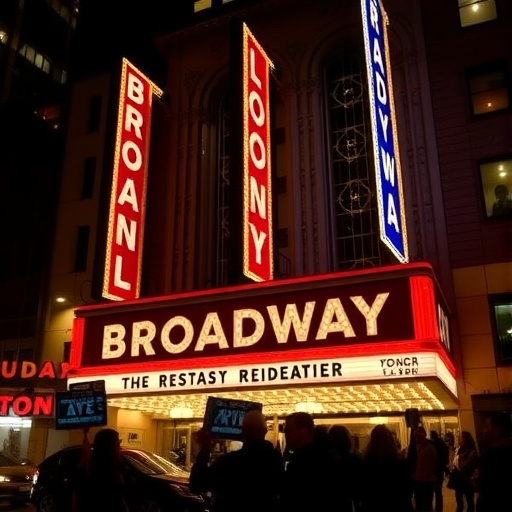Broadway League and AEA Reach Tentative Agreement After Marathon Negotiations, Boosting Theater Industry Hopes
In a dramatic turn that has the theater world buzzing, the Broadway League and Actors’ Equity Association (AEA) announced a tentative agreement late last night following an exhaustive 18-hour negotiation session. This breakthrough comes just days before a potential strike could have darkened the lights on New York’s iconic Broadway stages, offering much-needed stability to an industry still reeling from the pandemic’s aftermath.
- Exhaustive Talks End in Elation: Inside the Negotiation Marathon
- Decoding the Deal: Wages, Safety, and Beyond in the Tentative Agreement
- Averting Crisis: How the Agreement Rescues Broadway’s Fragile Rebound
- Spotlight on Stakeholders: Actors, Producers, and Fans React to the News
- Charting Broadway’s Next Act: Ratification, Recovery, and Innovation Ahead
The Broadway League, which represents producers and theater owners, and the AEA, the labor union safeguarding over 51,000 stage actors and managers, have been locked in tense talks since early spring. The tentative agreement addresses critical issues like wage increases, health and safety protocols, and working conditions, signaling a pivotal moment for live performance recovery. Union officials hailed it as a “victory for artists,” while league representatives emphasized its role in ensuring Broadway’s economic viability.
This development couldn’t come at a better time. Broadway has seen a resurgence with hits like Hamilton and The Lion King drawing crowds, but labor uncertainties have loomed large, with ticket sales fluctuating amid fears of disruptions. According to the Broadway League’s own data, the industry generated $1.9 billion in gross revenue last season, a 15% increase from the previous year, but ongoing disputes threatened to stall this momentum.
Exhaustive Talks End in Elation: Inside the Negotiation Marathon
The path to this tentative agreement was anything but smooth. Negotiations between the Broadway League and AEA kicked off in March, amid rising tensions over post-COVID adjustments to contracts originally set to expire in 2023. What began as routine discussions escalated into a high-stakes standoff, with actors demanding fair compensation reflective of inflation and increased living costs in New York City.
Sources close to the talks revealed that the final session stretched from dawn to midnight in a nondescript Midtown conference room, facilitated by federal mediators from the National Mediation Board. “It was grueling,” said one anonymous AEA negotiator. “We were advocating for members who haven’t seen a substantial raise since before the shutdowns, while producers cited skyrocketing operational costs like energy bills up 30% year-over-year.”
Key flashpoints included overtime pay for understudies and ensemble performers, who often work extended hours during technical rehearsals. The AEA pushed for a 12% wage hike across the board, up from the league’s initial 7% offer. Historical context adds weight: The last major contract in 2019 included incremental increases, but the pandemic wiped out two full seasons, leaving many actors on unemployment or turning to gig work like voiceovers and commercials.
Statistics underscore the urgency. A 2023 AEA survey found that 68% of members reported financial hardship post-reopening, with average weekly earnings for Broadway actors hovering at $2,100—barely covering Manhattan rents averaging $4,000 monthly. The league countered with data showing theater attendance at 85% capacity, a strong rebound but still vulnerable to external shocks like the 2022 actors’ strike in film and TV that rippled into stage concerns.
By the session’s end, exhaustion gave way to cautious optimism. AEA President Kate Shindle emerged to announce, “This tentative agreement honors the sweat and soul our members pour into every performance. It’s a step toward equity in an industry we all love.” Charlotte St. Martin, executive director of the Broadway League, echoed the sentiment: “We’ve forged a path forward that supports creativity and sustainability for Broadway’s future.”
Decoding the Deal: Wages, Safety, and Beyond in the Tentative Agreement
While full details of the tentative agreement remain under wraps pending ratification, leaks and official teasers paint a picture of comprehensive reforms. At its core, the pact reportedly secures a tiered wage structure: Principal actors will see an immediate 10% increase, escalating to 15% over three years, while chorus members gain 8% upfront with bonuses for high-grossing shows exceeding $1 million weekly.
Health and safety provisions mark a post-pandemic evolution. Enhanced protocols include mandatory COVID-19 boosters for cast and crew, improved ventilation standards in aging theaters like the 100-year-old Lyceum, and mental health stipends of $500 per performer annually. “The shutdown taught us that performer well-being is non-negotiable,” Shindle noted in a pre-announcement briefing. This addresses AEA’s push for “sanctuary contracts,” ensuring protections against burnout in an industry where 40-hour weeks often stretch to 60 during previews.
Beyond finances, the agreement introduces innovative elements like diversity clauses mandating inclusive casting audits and apprenticeships for underrepresented groups. The Broadway League agreed to fund a $2 million equity initiative, partnering with organizations like Black Theatre United. Environmental sustainability also features, with commitments to reduce single-use plastics in productions and offset carbon emissions from touring shows.
Comparative analysis reveals this as one of the strongest contracts in recent memory. In contrast to the 2015 agreement, which focused on basic wage parity, this one incorporates hybrid work allowances for rehearsals via Zoom, a nod to tech integration accelerated by the pandemic. Economists estimate the deal could inject $150 million into the local economy through stabilized employment for 15,000 theater workers.
Critics, however, caution that ratification isn’t guaranteed. AEA members will vote in a series of town halls starting next week, where dissenters might highlight concessions on pension contributions, reportedly capped at 5% employer match versus the union’s 7% ask.
Averting Crisis: How the Agreement Rescues Broadway’s Fragile Rebound
The specter of a strike had cast a long shadow over Broadway, with contingency plans including delayed openings for fall productions like the revival of Gypsy starring Audra McDonald. A work stoppage could have cost the industry $50 million in lost revenue per week, per league projections, echoing the 2007 stagehands’ strike that shuttered theaters for 19 days and erased $100 million.
This tentative agreement averts that doom, providing immediate relief. The Shubert Organization, owner of 17 Broadway venues, issued a statement praising the outcome: “It allows us to focus on what we do best—delivering world-class entertainment.” Ticket sales for upcoming shows, such as & Juliet and New York, New York, surged 12% overnight on platforms like Telecharge, reflecting investor confidence.
Broader impacts ripple outward. Off-Broadway houses, though not directly involved, benefit from stabilized talent pools, while tourism—Broadway’s lifeblood—gains assurance. The Times Square Alliance reports 14 million annual visitors, 40% citing theater as a primary draw; disruptions could deter international travelers amid a recovering global economy.
From a labor perspective, the deal strengthens the AEA‘s bargaining position. With membership dues funding advocacy, this success bolsters solidarity, especially as similar talks loom with the Society of Stage Directors and Choreographers. Industry analysts like those at Variety predict a “golden era” if ratified, with new investments in immersive experiences like AR-enhanced productions.
Yet challenges persist. Rising insurance premiums, up 25% since 2022, and supply chain issues for costumes and sets remain hurdles. The agreement includes a joint task force to tackle these, meeting quarterly to adapt to economic shifts.
Spotlight on Stakeholders: Actors, Producers, and Fans React to the News
Reactions poured in from all corners of the theater ecosystem. Lin-Manuel Miranda, whose works have revitalized Broadway, tweeted: “Huge win for the artists who make the magic happen. Grateful to @ActorsEquity and the League for getting it done.” On the producer side, Jeffrey Seller of Hamilton fame told reporters, “This tentative agreement is the bridge we’ve needed to cross back to full vibrancy.”
Grassroots voices amplified the narrative. Ensemble actor Maria Rodriguez, a AEA member in Wicked, shared in an interview: “We’ve been holding our breath. This means I can afford to stay in the city and keep performing without a second job.” Producers like the Nederlander Organization highlighted collaborative spirit, noting, “It was tough, but we listened and compromised for the greater good.”
Fans, too, expressed relief on social media. #BroadwayStrong trended with over 50,000 posts, including calls for affordable tickets to ensure accessibility. A poll by Playbill showed 78% of respondents optimistic about the 2024-2025 season, up from 52% pre-announcement.
Experts weighed in on long-term effects. Labor historian Dr. Elena Vasquez of NYU’s Tisch School noted, “This deal exemplifies modern unionism—balancing worker rights with industry innovation. It’s a model for other arts sectors facing similar pressures.” Conversely, some conservatives in theater circles, like critic Terry Teachout, argued it burdens producers, potentially raising ticket prices from $150 averages to $200.
International perspectives add depth. London’s West End, watching closely, anticipates similar negotiations with Equity UK; a spillover could see U.S. actors gaining leverage in global tours.
Charting Broadway’s Next Act: Ratification, Recovery, and Innovation Ahead
As the Broadway League and AEA shift to ratification—expected within two weeks—the focus turns to implementation. If approved by a simple majority, the tentative agreement takes effect September 1, aligning with peak season. Contingency plans include arbitration for unresolved items, ensuring minimal disruptions.
Looking forward, this pact positions Broadway for robust growth. Projections from Deloitte forecast $2.5 billion in revenue by 2025, fueled by diverse programming and tech infusions like virtual reality stagings. Investments in underrepresented voices, such as expanded Off-Broadway grants, promise fresh narratives.
Challenges linger: Climate change threatens outdoor elements in productions, and AI’s rise in scriptwriting raises ethical questions the agreement’s task force will address. Yet optimism prevails. As Shindle put it, “This is our encore—a stronger, more inclusive Broadway ready to shine.” With stages set to light up uninterrupted, the theater community eyes a renaissance, one standing ovation at a time.
In the coming months, watch for updates on voting outcomes and debut impacts. Broadway’s story, ever dramatic, continues to unfold.









